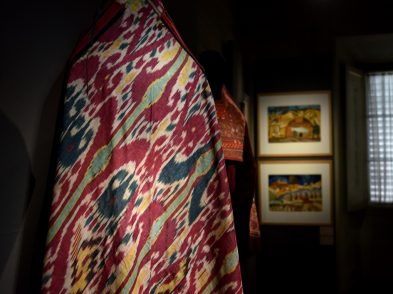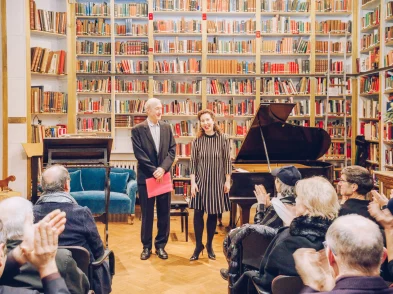The Florentine’s culture editor, Dr. Jane Fortune is known in Florence as ?Indiana Jane’ for her efforts to identify and restore art treasures by women artists in Florentine museums and deposits. Author and philanthropist, she is founder and chair of the Advancing Women Artists, a foundation whose latest project spotlighted the Accademia Gallery.
Imagine an eighteenth-century woman, wearing hoops and crinolines, atop scaffolding at dizzying heights, as she copies an enormous lunette beloved by Grand Duke Leopoldo. Moreover, she is working in the heat of summer, in an age when such a physically demanding task would normally be reserved for a man.
Irene Parenti Duclos (Florence, 1754-1795), a skilled Florentine copyist and painter, created her Madonna del Sacco by faithfully tracing Andrea del Sarto’s original. Located in the Church of Santa Maria Annunziata, the master’s fresco (1525) was already badly damaged by Duclos’s time. She is thought to have employed Vasari’s technique for tracing and transferring the design onto her canvas-an amazing feat considering the fresco’s height from the ground and its enormous size (5.9 x 12.6 feet).
Giuseppe Pelli Bencivenni, the director of the Uffizi Gallery at that time, saw her execute ?on top of the original’ and affirmed that Duclos ?was not making this work on commission, but for herself’ to uphold its memory. Impressed, Bencivenni informed the liberal-minded Grand Duke of her copy, and the latter promptly bought the Duclos painting for 100 gold zucchini and had it exhibited in the Pitti Palace, where it remained from 1781 to 1863. After Italy’s unification, the painting was moved to various storage sites until 1983, when it became part of the Accademia’s collection and was seen by the public for the first time in 120 years. Duclos’s lovely, monumental copy is special for another reason as well: it is her sole work currently on public view.
The quest to restore Duclos’s most significant painting did not entail having to salvage a work from centuries of decay, as it languished unseen in the bowels of a museum deposit. Instead, it began with a simple but singular request from the director of the Accademia: would my foundation, Advancing Women Artists, be interested in restoring the only painting by a woman in the Accademia’s stunning gallery where Michelangelo’s David reigns supreme. My answer was simple: ?Yes!’
Located in the Sala dell’Ottocento, the huge canvas hangs above the door, where one must crane his or her neck to see it. For hurried visitors, it may easily go unseen, but no inquisitive history lover can view Duclos’s work without wondering why this native Florentine artist has been so little researched or why history has been so slow to bring her life and works to the fore. However, there is yet reason to have new hope that Duclos will finally get her due: the copy’s restoration fortuitously coincided with the restoration of Andrea del Sarto’s original, sponsored by the Friends of Florence. And it is thanks to this happy coincidence that scholars and experts have had the chance to learn more about the strong-willed Duclos and her techniques.
Though little known, Duclos’s impressive endeavors cannot help but capture the imagination. Archival records show that she made a total of 39 oil copies and originals between 1773 and 1793, beginning at the age of 19. Copying from the masters was paramount to nineteenth-century artistic training in Florence, as Grand Tour travelers often commissioned local painters to reproduce large-scale works. Like other artists of her day, Duclos had to write to the director of the Uffizi Gallery and ask permission to copy each work in the galleries of Grand Duke Pietro Leopoldo. And she had to demonstrate the caliber of her talent before being allowed to replicate the works aristocratic foreigners most admired while on their visit to Italy.
A forerunner for other women artists, Duclos was successful in her lifetime and received the honor of being elected to the prestigious post of accademico professore by Florence’s Accademia di Belle Arti, the first drawing academy in Europe. Later, she founded a workshop in Florence, where she taught various techniques, including encaustic painting (hot wax painting with added colored pigments), which she learned in Rome.
In October 2011, there was a celebration of the restored Duclos, Madonna del Sacco, with a one-day conference featuring some of the city’s top scholars and technical experts, whose recent research has been compiled in a new dual-language publication from The Florentine Press, Irene Parenti Duclos: A Work Restored, an Artist Revealed. It represents a much-awaited opportunity to celebrate one of Florence’s most noteworthy talents.
For those who have worked toward the project’s fulfillment, this moment is a point of departure rather than a point of arrival. Several of Duclos’s paintings, including an exquisite self-portrait (1783) and her portrait of the Austrian numismatist Joseph Hilarius Eckhel (commissioned by Uffizi Director Raimondo Cocchi in 1773), remain in storage at the Uffizi. Of the 39 oil paintings (both copies and originals) that Duclos created-only 3 have been traced. The mystery remains unsolved: where are the other 36? Certainly, we have only scratched the surface. The journey has truly begun, for the quest continues.
Jane Fortune
The Florentine, culture editor
Buy the book – Irene Parenti Duclos: A Work Restored, an Artist Revealed








